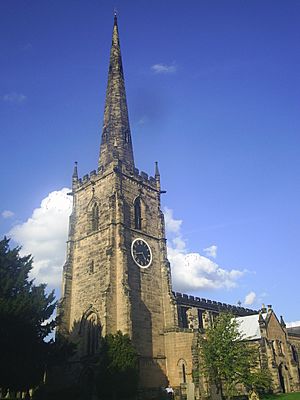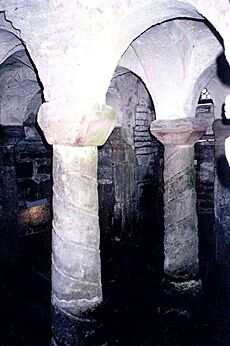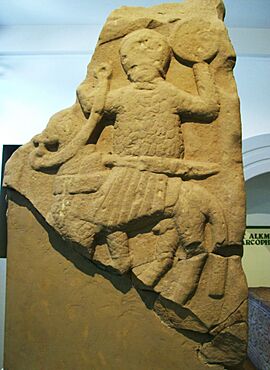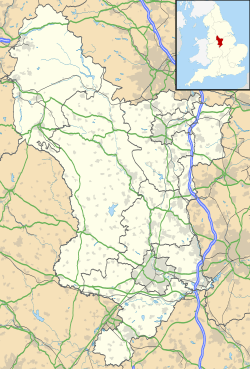St Wystan's Church, Repton facts for kids
Quick facts for kids St Wystan's Church, Repton |
|
|---|---|

Repton Church
|
|
| 52°50′26″N 01°33′11″W / 52.84056°N 1.55306°W | |
| OS grid reference | SK 303 272 |
| Country | England |
| Denomination | Church of England |
| Churchmanship | Broad Church |
| Website | reptonchurch.uk |
| History | |
| Status | Parish church |
| Founded | Repton Abbey established c. 600AD |
| Founder(s) | Saint David (traditionally) |
| Dedication | St Wystan |
| Relics held | St Wystan (moved by King Cnut to Evesham Abbey) |
| Architecture | |
| Functional status | Active |
| Heritage designation | Grade I listed |
| Designated | 19 January 1967 |
| Architect(s) | Arthur Blomfield (restoration) |
| Architectural type | Church |
| Style | Anglo-Saxon, Gothic |
| Specifications | |
| Spire height | 212 feet (65 m) |
St Wystan's Church is a very old church in Repton, Derbyshire, England. It's famous for its amazing Anglo-Saxon crypt. This crypt was once the burial place of two ancient Mercian kings. The church is a special Grade I listed building, meaning it's very important historically. It's named after Saint Wystan, an Anglo-Saxon saint who was once buried there.
Contents
About the Church Building
The original Anglo-Saxon church was shaped like a cross. It might have had a tower in the middle. The main part of the current church, called the nave, has Medieval Gothic side sections, called aisles. These were rebuilt in the 1200s and made wider in the early 1300s.
Tower and Spire
The tall tower at the west end and its pointed top, called a spire, were added around 1340. The very top of the spire is about 64 meters (212 feet) high. In the 1400s, the upper windows of the nave, called the clerestory, were built. A wooden roof and a two-story entrance porch were also added. The tower windows were changed too.
Inside the Church
Inside the church, you can see old monuments. There's a stone statue of a knight from about 1400. There are also monuments to members of the Thacker family from the 1500s and 1700s. The tower has eight bells that can be rung. The oldest bell was made in Leicester around 1500.
The church was repaired and updated between 1885 and 1886. This work was done by an architect named Arthur Blomfield.
The Ancient Crypt and Royal Burials

The crypt is a very old part of the church, built in the early 700s. It was built over a natural spring. People think it might have first been used as a baptistery, a place for baptisms.
A Royal Burial Place
This special space was later turned into a mausoleum for King Æthelbald of Mercia. He was a powerful king of Mercia. King Wiglaf and his grandson, Saint Wigstan, were also buried in this crypt. The church is named after Saint Wigstan. It's believed that the royal bodies were first buried in the ground. Later, their bones were moved into the crypt.
After Saint Wigstan was buried there, the crypt became a popular place for people to visit on a pilgrimage. However, when the Vikings invaded, Saint Wigstan's body was taken away by monks who were escaping. It was later brought back. But in the 900s, King Cnut had Saint Wigstan's remains moved again. They were reburied at Evesham Abbey in Worcestershire.
Important Anglo-Saxon Architecture
A famous expert named Nikolaus Pevsner said that the Anglo-Saxon parts of St Wystan's Church are "one of the most precious survivals of Anglo-Saxon architecture in England." Besides the crypt, these parts include the chancel (the area around the altar), and parts of the crossing and north transept.
The crypt is a square room with a special roof. The roof has three rows of three dome-shaped sections. These sections are held up by pillars built into the walls and four free-standing pillars in the middle.
Some people think that the design of Repton's crypt influenced other important buildings. These include the shrine of Edward the Confessor and the Coronation Pavement in Westminster Abbey. Both were ordered by King Henry III.
Kings and Princes Buried Here
- King Æthelbald of Mercia – died in 757
- King Wiglaf of Mercia – died in 839
- Prince/Saint Wigstan – died in 849 (his remains were later moved by King Cnut to Evesham Abbey)
Archaeological Discoveries
In the 1980s, archaeologists found a huge grave near St Wystan's Church. It was in a mound built over an old Saxon chapel. This grave is thought to be linked to the Great Heathen Army, a large group of Vikings.
The Viking Mass Grave
The grave contained about 300 human skeletons. About 20% of them were women, and the other 80% were men aged 18 to 45. Many of the skeletons showed signs of violent injuries. Viking items, like a Thor pendant, were found among the bones.
At first, scientists thought the bodies were from different centuries. But in 2018, a team from the University of Bristol announced that all the remains were from the late 800s AD. This matches the time when the Viking army stayed in Derbyshire for the winter. The earlier dating problem was due to the Vikings eating a lot of seafood, which can affect carbon dating results.
The Repton Stone

Outside the crypt, a special stone called the Repton Stone was found in 1979. It's the top part of an old standing cross. One side of the stone has a carving of a person riding a horse. The figure is a man wearing armor and holding a sword and shield. He also has a crown on his head.
This mounted figure has been identified as King Æthelbald of Mercia. King Æthelbald was killed in 757 and buried at Repton. If this is truly King Æthelbald, it would be the oldest large picture of an English king ever found. The Repton Stone is now on display at the Derby Museum and Art Gallery.
Monuments Inside the Church
The church has several monuments to different people:
- South transept: George Waklin (died 1617) and Ellen Waklin (died 1614), John Macauley (died 1840), Thomas Whitehead (died 1645, monument put up in 1802).
- South aisle: Gilbert Thacker (died 1563).
- North aisle: Rev Joseph James (died 1856), William Bagshaw Stevens (died 1800), Francis Thacker (died 1710).
Churchyard
The churchyard is the area around the church where people are buried. It contains the war graves of 17 soldiers and airmen from the Commonwealth. Most of these were Royal Air Force members who died in World War II.
Also buried here are the ashes of C. B. Fry. He was a famous English sportsman. His tombstone, put in place in 2008, calls him a "Cricketer, Scholar, Athlete, Author – The Ultimate All-rounder."
Church Organ
The church has a pipe organ built in 1998 by Peter Collins. It has two keyboards and 23 different sounds, called "stops."
Parish Status
St Wystan's Church is part of a group of churches. It shares a parish with:
See also
- Grade I listed churches in Derbyshire
- Grade I listed buildings in Derbyshire
- Listed buildings in Repton
- Repton Abbey


